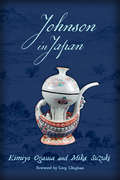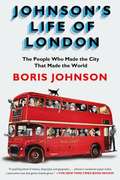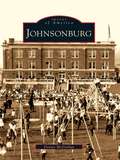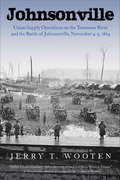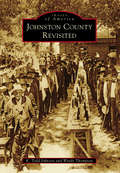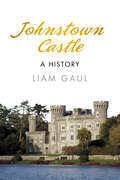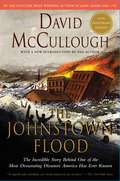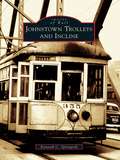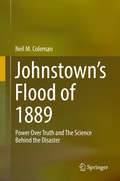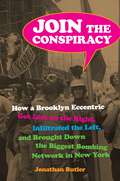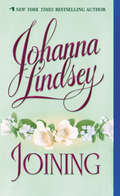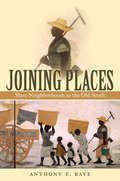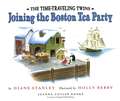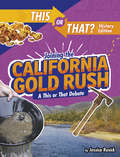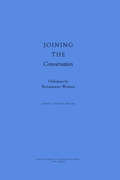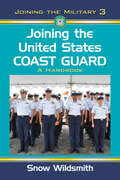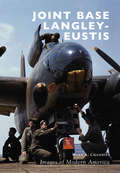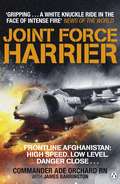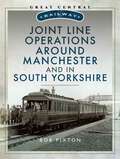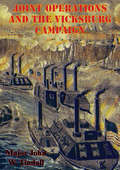- Table View
- List View
Johnson City (Images of America)
by Sonya A. HaskinsThe Johnson City area was originally settled in 1777 by pioneers from North Carolina with land grants. Dissatisfied with their representation in North Carolina, local citizens held a convention and formed the state of Franklin in 1784. This state was never recognized by Congress. It fizzled out in 1788, and Tennessee was formed in 1796. More settlers came to the new state, but the area was destined to grow into a city when a combination of railroad connections in the area sparked growth during the late 19th century. In 1903, the creation of the National Soldiers Home brought disabledveterans of the Spanish-American War and the Civil War to Johnson City. Readers of this book will enjoy viewing photographs and reading about early residents, prominent homes, and historic buildings such as the East Tennessee Normal School, which opened in 1911. Many of the more than 200 photographs in this volume have never beforebeen published.
Johnson in Japan
by Hideichi Eto Noriyuki Harada Yuri Yoshino Miki Iwata Noriyuki Hattori Tadayuki Fukumoto Masaaki Ogura Hitoshi SuwabeThe study and reception of Samuel Johnson’s work has long been embedded in Japanese literary culture. The essays in this collection reflect that history and influence, underscoring the richness of Johnson scholarship in Japan, while exploring broader conditions in Japanese academia today. In examining Johnson’s works such as the Rambler (1750-52), Rasselas (1759), Lives of the Most Eminent English Poets (1779-81), and Journey to the Western Islands of Scotland (1775), the contributors—all members of the half-century-old Johnson Society of Japan—also engage with the work of other important English writers, namely Shakespeare, Mary Shelley, Jane Austen, and Matthew Arnold, and later Japanese writers, including Natsume Soseki (1867-1916). If the state of Johnson studies in Japan is unfamiliar to Western academics, this volume offers a unique opportunity to appreciate Johnson’s centrality to Japanese education and intellectual life, and to reassess how he may be perceived in a different cultural context. <P><P> Published by Bucknell University Press. Distributed worldwide by Rutgers University Press.
Johnson's Life of London: The People Who Made the City that Made the World
by Boris JohnsonThe exhilarating story of how London came to be one of the most exciting and influential places on earth—from the city&’s colorful, witty, and well-known mayor.Once a swampland that the Romans could hardly be bothered to conquer, over the centuries London became an incomparably vibrant metropolis that has produced a steady stream of ingenious, original, and outsized figures who have shaped the world we know.Boris Johnson, the internationally beloved mayor of London, is the best possible guide to these colorful characters and the history in which they played such lively roles. Erudite and entertaining, he narrates the story of London as a kind of relay race. Beginning with the days when &“a bunch of pushy Italian immigrants&” created Londinium, he passes the torch on down through the famous and the infamous, the brilliant and the bizarre—from Hadrian to Samuel Johnson to Winston Churchill to the Rolling Stones—illuminating with unforgettable clarity the era each inhabited. He also pauses to shine a light on innovations that have contributed to the city&’s incomparable vibrancy, from the King James Bible to the flush toilet.As wildly entertaining as it is informative, this is an irresistible account of the city and people that in large part shaped the world we know.
Johnsonburg (Images of America)
by Dennis McgeehanJohnsonburg, the "Paper City," is situated at the juncture of the east and west branches of the Clarion River in Pennsylvania's Allegheny Mountains. Its prime location guaranteed that this vibrant community in Elk County would flourish. Surrounded by trees, Johnsonburg made a living from wood. Sawmills, tanneries, and a large paper mill have dominated the lives of the Italian immigrants and other groups that settled in town. River transportation gave way to railroads, and Johnsonburg became a hub of rail carriers moving freight and passengers. Its riverside location also had disadvantages, and the history of the community is measured in flood years. Johnsonburg was frequently flooded, but the people never gave in to hard times. Today Johnsonburg is still mostly surrounded by trees, and the forests have made the area a sporting paradise. Hunting, fishing, and outdoor recreation are an important part of the modern economy.
Johnsonville: Union Supply Operations on the Tennessee River and the Battle of Johnsonville, November 4–5, 1864
by Jerry T. Wooten“Johnsonville” doesn’t mean much to most students of the Civil War. Its contribution to Union victory in the Western Theater, however, is difficult to overstate, and its history is complex, fascinating, and heretofore mostly untold. Johnsonville: Union Supply Operations on the Tennessee River and the Battle of Johnsonville, November 4–5, 1864, by Jerry T. Wooten, Ph.D., now available in paperback, remedies that oversight with the first full-length treatment of this subject. Wooten, a former Park Manager at Johnsonville State Historic Park, unearthed a wealth of new material that sheds light on the creation and strategic role of the Union supply depot, the use of railroads and logistics, and the depot’s defense. His study covers the emergence of a civilian town around the depot, and the role all of this played in making possible the Union victories with which we are all familiar. This sterling monograph also includes the best and most detailed account of the Battle of Johnsonville. The fighting took place on the heels of one of the most audacious campaigns of the war, when Confederate Maj. Gen. Nathan Bedford Forrest led his cavalry through western Tennessee and Kentucky on a 25-day campaign. On November 4–5, 1864, Forrest’s troops attacked the depot and shelled the town, destroying tons of valuable supplies. The complex land-water operation nearly wiped out the Johnsonville supply depot, severely disrupted Gen. George Thomas’s army in Nashville, and impeded his operations against John Bell Hood’s Confederate army. Prior works on Johnsonville focus on Forrest’s operations, but Wooten’s deep original archival research peels back the decades to reveal significantly more on that battle, as well as what life was like in and around the area for both military men and civilians. Civil War students thirst for original deeply researched studies on fresh topics, and that is exactly what Johnsonville: Union Supply Operations on the Tennessee River and the Battle of Johnsonville, November 4–5, 1864 provides them.
Johnston County Revisited
by K. Todd Johnson Windy ThompsonCreated in 1746, Johnston County is located along the fall line between North Carolina's Piedmont and Coastal Plain regions. Smithfield, on the Neuse River, has been the county seat since 1771. In 1856, Johnston County became part of the Fertile Crescent along the east-west North Carolina Railroad, which spawned the thriving towns of Princeton, Pine Level, Selma, and Clayton. In the 1880s, a north-south rail line, eventually known as the Atlantic Coastline, brought Kenly, Micro, Four Oaks, and Benson into existence. Johnston County boasts film legend Ava Gardner, bootleg kingpin Percy Flowers, Vicks VapoRub, and other local claims to fame. It is still a farming county, although recent growth from the Research Triangle region has brought marked changes to the rural landscape. In recent years, Wilson's Mills and Archer Lodge have gained corporate status. These historical images tell a story not only of the extraordinary people who have called Johnston County home but also of the ordinary, everyday individuals who have left their mark.
Johnstown Basketball: The Cambria County War Memorial Invitational Tournament (Sports)
by Bradley A. HuebnerAmid a series of three destructive floods that pounded little Johnstown, Pennsylvania, in less than a century, Cambria County residents somehow maintained their lofty expectations and big-picture foresight to begin what would become the oldest Christmas high school basketball tournament in the nation, as they would boast. Learn the amazing history behind an historic hardwood tournament.
Johnstown Castle: A History
by Liam GaulThe harmony between great castles and their ornamental grounds is rarely seen in such perfect form as at Johnstown Castle. The gardens and grounds were designed by Daniel Robertson, of Powerscourt fame, assisted by Martin Day. The castle itself was home to two prominent Wexford families, the Esmondes and the Grogans, who have between them occupied the grounds from the fifteenth century right up to 1945. Today the castle is owned by Teagasc, the Agricultural and Food Development Authority, who manage the estate and provide access to the public. This book is the first published history of the castle, and in these pages author, historian and Wexford native Liam Gaul, explores the development of this imposing aspect of Wexford and national heritage from its earliest beginnings.
Johnstown Flood: The Incredible Story Behind One Of The Most Devastating "natural" Disasters America Has Ever Known
by David McCulloughThe stunning story of one of America’s great disasters, a preventable tragedy of Gilded Age America, brilliantly told by master historian David McCullough.At the end of the nineteenth century, Johnstown, Pennsylvania, was a booming coal-and-steel town filled with hardworking families striving for a piece of the nation’s burgeoning industrial prosperity. In the mountains above Johnstown, an old earth dam had been hastily rebuilt to create a lake for an exclusive summer resort patronized by the tycoons of that same industrial prosperity, among them Andrew Carnegie, Henry Clay Frick, and Andrew Mellon. Despite repeated warnings of possible danger, nothing was done about the dam. Then came May 31, 1889, when the dam burst, sending a wall of water thundering down the mountain, smashing through Johnstown, and killing more than 2,000 people. It was a tragedy that became a national scandal. Graced by David McCullough’s remarkable gift for writing richly textured, sympathetic social history, The Johnstown Flood is an absorbing, classic portrait of life in nineteenth-century America, of overweening confidence, of energy, and of tragedy. It also offers a powerful historical lesson for our century and all times: the danger of assuming that because people are in positions of responsibility they are necessarily behaving responsibly.
Johnstown Trolleys and Incline
by Kenneth C. SpringirthThe Johnstown flood on May 31, 1889, virtually demolished the horsecar lines of the Johnstown Passenger Railway Company, resulting in the system being rebuilt with electric trolley cars. Johnstown Trolleys and Incline covers the history of the trolley car system, trackless trolleys, and the Johnstown Inclined Plane. Johnstown was the last small city in the United States to operate a variety of vintage and modern trolley cars along with trackless trolleys. The Johnstown incline played a key role in transporting residents to higher ground in the devastating floods of 1936 and 1977. Ridership declined with the coming of the automobile and the changing industrial scene in the region. Rail enthusiasts from all parts of the country came to Johnstown on its last day of trolley service in 1960, and the last runs are fully illustrated in these vintage photographs.
Johnstown’s Flood of 1889: Power Over Truth and The Science Behind the Disaster
by Neil M. ColemanScience now reveals the true cause of the dam breach flood that destroyed Johnstown in 1889. The tragic loss of more than 2200 lives was preventable; the initial investigation of the flood was hijacked, delayed, and distorted by powerful members of the industrial elite. This book bridges the gap between history and science, reexamining eyewitness accounts of the flood and historic documents about the investigation, and applying new LiDAR, GPS, and hydraulic studies to solve the mystery – what caused the Great Flood of 1889? The book includes a notable chapter on the “sister” of the South Fork Dam, “The Forgotten Dam” at Hollidaysburg, PA.
Join the Conspiracy: How a Brooklyn Eccentric Got Lost on the Right, Infiltrated the Left, and Brought Down the Biggest Bombing Network in New York
by Jonathan ButlerDive into the electrifying tale of a Brooklyn-born patriot turned radical activist, in an era when America was torn by its ideological extremesIn the shadow of recent turmoil, Join the Conspiracy transports readers to a pivotal moment of division and dissent in American history: the late 1960s. Against the backdrop of the Vietnam War and a nation grappling with internal conflict, this compelling narrative follows the life of George Demmerle, a factory worker whose political odyssey encapsulates the era’s tumultuous spirit. From his roots as a concerned citizen wary of his country’s leftward tilt, Demmerle’s journey takes a dramatic turn as he delves into the heart of radical activism. Participating in iconic protests from the March on Washington to the Democratic National Convention in Chicago, Demmerle’s story is a whirlwind of political fervor, embodying the struggle against what was perceived as imperialist war and racial injustice. His transformation is marked by alliances with key figures of the time, including Abbie Hoffman, and an eventual leadership role within an East Coast Black Panther affiliate. Yet, beneath his radical veneer lies a secret: Demmerle is an FBI informant. Join the Conspiracy reveals Demmerle’s complex role in a society at war with itself, where his deepening involvement with the radical left and a bombing collective forces him to confront his loyalties. The narrative, enriched by a rare trove of period documents, candid photos taken from inside the radical movement, and underground art—more than a hundred of which are included in the book—not only charts Demmerle’s saga but also reflects the broader story of a nation struggling to find its moral compass amidst chaos. As Demmerle navigates the dangerous waters of political extremism, readers are invited to ponder the price of ideology, the nature of loyalty, and the fine line between activism and betrayal. This book is not just a recounting of historical events but a vibrant portrait of a man and a movement that sought to reshape America.
Joining (Shefford's Knights #2)
by Johanna LindseyThe remarkable Lindsey magic is stronger than ever! The spectacular #1 bestselling author returns with a glorious tale of passion and duty set in medieval England. A betrothal has been announced that will join together Britain's two most powerful families , a union of wealth and influence to rival even the King's himself. But not only does the dangerously ambitious King John oppose this wedding, but Milisant and Wulfric : the intended bride and groom , are equally unhappy with the arrangement. Two passionate, headstrong people, they resent being thrown together for purely dynastic reasons. But fate's many twists and turns , and the unpredictable predilections of two unconquerable hearts will turn an unwanted marriage of convenience into a true and eternal joining of desire and love.
Joining Hitler’s Crusade
by David StahelThe reasons behind Hitler's invasion of the Soviet Union are well known, but what about those of the other Axis and non-Axis powers that joined Operation Barbarossa? Six other European armies fought with the Wehrmacht in 1941 and six more countries sent volunteers, as well as there being countless collaborators in the east of various nationalities who were willing to work with the Germans in 1941. The political, social and military context behind why so many nations and groups of volunteers opted to join Hitler's war in the east reflects the many diverse, and largely unknown, roads that led to Operation Barbarossa. With each chapter dealing with a new country and every author being a subject matter expert on that nation, proficient in the local language and historiography, this fascinating new study offers unparalleled insight into non-German participation on the Eastern Front in 1941.
Joining Places
by Anthony E. KayeIn this new interpretation of antebellum slavery, Anthony Kaye offers a vivid portrait of slaves transforming adjoining plantations into slave neighborhoods. He describes men and women opening paths from their owners' plantations to adjacent farms to go courting and take spouses, to work, to run away, and to otherwise contend with owners and their agents. In the course of cultivating family ties, forging alliances, working, socializing, and storytelling, slaves fashioned their neighborhoods into the locus of slave society.Joining Places is the first book about slavery to use the pension files of former soldiers in the Union army, a vast source of rich testimony by ex-slaves. From these detailed accounts, Kaye tells the stories of men and women in love, "sweethearting," "taking up," "living together," and marrying across plantation lines; striving to get right with God; carving out neighborhoods as a terrain of struggle; and working to overthrow the slaveholders' regime. Kaye's depiction of slaves' sense of place in the Natchez District of Mississippi reveals a slave society that comprised not a single, monolithic community but an archipelago of many neighborhoods. Demonstrating that such neighborhoods prevailed across the South, he reformulates ideas about slave marriage, resistance, independent production, paternalism, autonomy, and the slave community that have defined decades of scholarship.In this new interpretation of antebellum slavery, Anthony Kaye offers a vivid portrait of slaves transforming adjoining plantations into slave neighborhoods. He describes men and women opening paths from their owners' plantations to adjacent farms to go courting and take spouses, to work, to run away, and to otherwise contend with owners and their agents. Demonstrating that neighborhoods prevailed across the South, Kaye reformulates ideas about slave marriage, resistance, independent production, paternalism, autonomy, and the slave community that have defined decades of scholarship. This is the first book about slavery to use the pension files of former soldiers in the Union army, a vast source of rich testimony by ex-slaves.-->
Joining al-Qaeda: Jihadist Recruitment in Europe (Adelphi series)
by Peter R. NeumannIn Britain alone, several thousand young Muslims are thought to be part of violent extremist networks. How did they become involved? What are the mechanisms and dynamics through which European Muslims join al-Qaeda and groups inspired by al-Qaeda? This paper explains the processes whereby European Muslims are recruited into the Islamist militant movement. It reveals that although overt recruitment has been driven underground, prisons and other ‘places of vulnerability’ are increasingly important alternatives. It explores the recruitment roles of radical imams, gateway organisations and activists, and highlights the kinds of message that facilitate the recruitment process. It also shows how the Internet has come to play an increasingly significant role. Neumann argues that there is little evidence of systematic, top-down jihadist recruitment in Europe. Rather, the activist leaders of cells increasingly drive the process. The paper explores possible options for European governments wishing to disrupt violent extremist networks, recognising that it will also be necessary to address some of the underlying risk factors that fuel jihadist recruitment. Ultimately, the major challenge for European states lies in constructing more inclusive societies in which the narratives of exclusion and grievance will not resonate to the benefit of recruiters to the extremist cause.
Joining the Boston Tea Party (The Time-Traveling Twins)
by Diane StanleyLiz, Lenny, and Grandma are back for another time-traveling adventure. With the Fourth of July fast approaching, there's only one thing for them to do ... Join the Boston Tea Party! With the help of Grandma's magic hat, the twins journey back to Boston in 1773. From powdered wigs and petticoats to Indian pudding and chamber pots, Liz and Lenny get a firsthand look at life in colonial America. But best of all they actually join the "Mohawks" as they dump tea into Boston Harbor and help begin the American Revolution. Diane Stanley once again blends humor and historical detail in this exciting second installment of the Time-Traveling Twins series. Featuring word balloons packed with comedy and lots of information, and Holly Berry's inviting illustrations, this book will make readers jump at the chance to join the twins as they learn about history by living it!
Joining the California Gold Rush: A This or That Debate (This or That?: History Edition)
by Jessica RusickAfter gold was discovered in California in 1848, thousands of people rushed there to strike it rich. They faced tough choices at every turn. Now the choices are yours. Would you rather use the slower method of panning for gold or use a more dangerous method of hydraulic mining? Would you rather run a store or a hotel in a California boomtown? It's your turn to pick this or that!
Joining the Conversation: Dialogues by Renaissance Women
by Janet SmarrAvoiding the male-authored model of competing orations, French and Italian women of the Renaissance framed their dialogues as informal conversations, as letters with friends that in turn became epistles to a wider audience, and even sometimes as dramas. No other study to date has provided thorough, comparative view of these works across French, Italian, and Latin. Smarr's comprehensive treatment relates these writings to classical, medieval, and Renaissance forms of dialogue, and to other genres including drama, lyric exchange, and humanist invective--as well as to the real conversations in women's lives--in order to show how women adapted existing models to their own needs and purposes.
Joining the United States Coast Guard: A Handbook (Joining the Military #3)
by Snow WildsmithThis book is for the teenager or young adult who is interested in enlisting in the United States Coast Guard. It will walk him or her through the enlistment and recruit training process: making the decision to join, talking to recruiters, getting qualified, preparing for basic training, and learning what to expect at basic recruit training. The goal is to help young people who might be curious about serving in the Coast Guard decide if it is right for them, if they are qualified for and prepared for it and if the Navy, Army or Marine Corps would be a better fit.
Joinings: Compound Words in Old English Literature
by Jonathan Davis-SecordThe first comprehensive study of the use of compound words in Old English poetry, homilies, and philosophy, Joinings explores the effect of compounds on style, pace, clarity, and genre in Anglo-Saxon vernacular literature. Jonathan Davis-Secord demonstrates how compounds affect the pacing of passages in Beowulf, creating slow-motion narrative at moments of significant violence; how their structural complexity gives rhetorical emphasis to phrases in the homilies of Wulfstan; and how they help to mix quotidian and elevated diction in Cynewulf's Juliana and the Old English translations of Boethius. His work demonstrates that compound words were the epitome of Anglo-Saxon vernacular verbal art, combining grammar, style, and culture in a manner unlike any other feature of Old English.
Joint Base Langley-Eustis (Images of Modern America)
by Mark A. ChambersJoint Base Langley-Eustis (JBLE) has served for over 100 years as a cornerstone of American military aviation. The base has served as a flight test center for US Navy seaplanes and observation/spotter aircraft, as well as the ill-fated Roma airship. Additionally, JBLE was one of the first US Air Force (USAF) bases to operate the advanced Lockheed F-22 Raptor. In 1921, Langley Field served as the launching point for Gen. William “Billy” Mitchell’s US Army Air Service efforts in historic battleship bombing flight experiments. Prior to World War II, Langley Field became the first US Army Air Corps base to operate the Boeing YB-17, prototype of the famous B-17 Flying Fortress. During the latter half of the 20th century, Langley Air Force Base served as the headquarters for the Tactical Air Command (TAC) and the Air Combat Command (ACC). JBLE still serves as ACC headquarters.
Joint Force Harrier
by Adrian Orchard James BarringtonDays after arriving in Kandahar, the Harriers of 800 Naval Air Squadron were in the thick of fierce fighting. Armed with rockets and bombs, the pilots were flying crucial danger-close attack missions in defence of troops engaged in the most intense battles seen by British forces since the Korean War. While facing the constant threat of surface-to-air missiles, the British Top Guns knew that any mistake would have fatal consequences for the soldiers who depended on their skill and determination. Written by the Commanding Officer of the first Royal Navy squadron to deploy to Afghanistan, Joint Force Harrier is a compelling insight into the exciting world of modern air warfare.
Joint Line Operation Around Manchester and in South Yorkshire (Great Central Railway)
by Bob PixtonJoint Operations Around Manchester and in South Yorkshire, is the latest volume in a series of books by Robert Pixton, covering the lines across the Pennines, especially those of the former Great Central. This volume looks at the joint lines that once served the area from Lancashire to Yorkshire, serving heavy industry and providing an intense passenger service in the 19th and early 20th centuries. The lines and services declined on many of the branch lines and some of the cross country lines by the 1950s, heralding there final demise in the early 1960s, as a result of the Reshaping of British Railways. Today there are still a few important corridors crossing this area of the north of England, which have become increasingly important in recent times as roads become more congested and bus services are cut back.
Joint Operations And The Vicksburg Campaign
by Major John W. TindallThis historical study investigates why Union joint operations between army and navy forces on the Mississippi and other western rivers were effective. It examines the development of a joint doctrine at the strategic, operational, and tactical levels of war.Joint riverine warfare on the western rivers was a new experience for the U.S. military. There was no clear delineation between services of specific missions or responsibilities. Joint operations incorporated numerous battlefield operating systems that the leadership had to integrate and synchronize.At the strategic level, Washington attempted to provide adequate vessels and other resources for the war on the rivers. However, the national leadership never did institute an adequate joint command and control structure for the Western Theater.The army operational commanders came to depend on the advice of the naval officers for acquiring vessels and advice on water-borne operations. On the other hand, the naval officers relied on the infrastructure of an established army to facilitate their operations.The personalities of the joint leadership were important factors in the success of joint warfare. Grant, Sherman, and Porter developed a special relationship, which allowed them to overcome tactical disagreements, and maintain a clear focus on the strategic objective of capturing Vicksburg.

